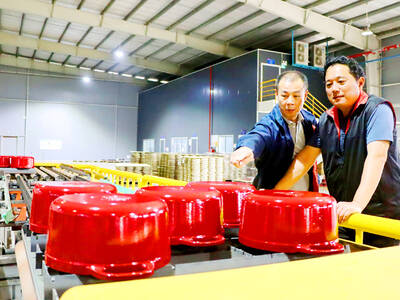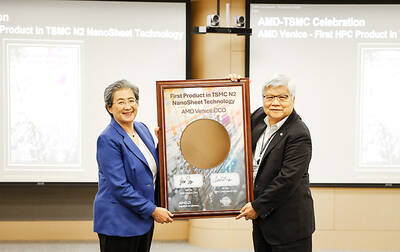Evergreen Marine Corp (長榮海運) on Tuesday said it expects a rebound in its cargo volume in the third quarter after facing an up to 20 percent plunge in the first half of the year due to the COVID-19 pandemic.
However, as uncertainties remain in the fourth quarter, the company’s annual cargo volume might fall 15 percent year-on-year for the whole of this year, the nation’s largest cargo shipper said.
While the pandemic has decelerated economic activity worldwide and weakened demand in the global container shipping market, Evergreen saw demand pick up earlier this month and has received more orders for next month and August, company chairman Anchor Chang (張正鏞) told a news briefing in Taipei.

Photo: Bloomberg
Summer is traditionally the cargo shipping industry’s peak season, as many suppliers transport their goods for clients ahead of product launches.
“The cargo volume in the third quarter is likely to be flat from last year, but it would be a decent performance considering the effects of the pandemic,” Chang said. “It is difficult to see annual growth in volume this year, as global trade declines and consumption slows due to lockdown measures.”
The world’s three major container shipping alliances — the Alliance, 2M Alliance and Ocean Alliance — have reduced their capacity amid the outbreak to address oversupply in the industry, which helps shippers maintain load factors and curb declines in freight rates, Evergreen executive vice president Patrick Wei (魏維德) said.
A reduction in capacity would have a mixed effect on shippers’ financial performance, as it would lead to a drop in revenue while saving their operational costs, such as fuel and labor costs, Wei said.
Most shippers in the past few months have performed maintenance on their idle vessels, while Evergreen has equipped its idle vessels with scrubbers to reduce emissions and meet new International Maritime Organization regulations, Wei said.
“It is questionable whether most shippers would continue trimming capacity in the fourth quarter when the cargo demand recovers, but if all shippers return to full capacity, the oversupply issue would emerge again,” he said.
For Evergreen, revenue generated from the Asia-Europe route and the Asia-US route accounts for 65 percent of its total revenue.
A second wave of COVID-19 in the West could complicate fourth-quarter visibility for cargo volume, he said.
The shipper has reported no infections among its crews, saying that it bars them from disembarking when arriving at any port and does not allow families aboard.
Evergreen also routinely takes its crews’ temperatures and orders them to self-isolate before boarding, it said.
The company added that it has extended contracts with crew members who could not return home due to border restrictions.
“This is a challenging year for shippers,” Chang said.
Evergreen reported a net loss of NT$441.3 million (US$14.89 million) for the first quarter, after revenue fell 4.86 percent year-on-year to NT$43.48 billion.
Net loss per share was NT$0.09 in the first quarter, compared with earnings per share of NT$0.12 a year earlier.

UNCERTAINTY: Innolux activated a stringent supply chain management mechanism, as it did during the COVID-19 pandemic, to ensure optimal inventory levels for customers Flat-panel display makers AUO Corp (友達) and Innolux Corp (群創) yesterday said that about 12 to 20 percent of their display business is at risk of potential US tariffs and that they would relocate production or shipment destinations to mitigate the levies’ effects. US tariffs would have a direct impact of US$200 million on AUO’s revenue, company chairman Paul Peng (彭雙浪) told reporters on the sidelines of the Touch Taiwan trade show in Taipei yesterday. That would make up about 12 percent of the company’s overall revenue. To cope with the tariff uncertainty, AUO plans to allocate its production to manufacturing facilities in

TAKING STOCK: A Taiwanese cookware firm in Vietnam urged customers to assess inventory or place orders early so shipments can reach the US while tariffs are paused Taiwanese businesses in Vietnam are exploring alternatives after the White House imposed a 46 percent import duty on Vietnamese goods, following US President Donald Trump’s announcement of “reciprocal” tariffs on the US’ trading partners. Lo Shih-liang (羅世良), chairman of Brico Industry Co (裕茂工業), a Taiwanese company that manufactures cast iron cookware and stove components in Vietnam, said that more than 40 percent of his business was tied to the US market, describing the constant US policy shifts as an emotional roller coaster. “I work during the day and stay up all night watching the news. I’ve been following US news until 3am

Taiwan will prioritize the development of silicon photonics by taking advantage of its strength in the semiconductor industry to build another shield to protect the local economy, National Development Council (NDC) Minister Paul Liu (劉鏡清) said yesterday. Speaking at a meeting of the legislature’s Economics Committee, Liu said Taiwan already has the artificial intelligence (AI) industry as a shield, after the semiconductor industry, to safeguard the country, and is looking at new unique fields to build more economic shields. While Taiwan will further strengthen its existing shields, over the longer term, the country is determined to focus on such potential segments as

COLLABORATION: Given Taiwan’s key position in global supply chains, the US firm is discussing strategies with local partners and clients to deal with global uncertainties Advanced Micro Devices Inc (AMD) yesterday said it is meeting with local ecosystem partners, including Taiwan Semiconductor Manufacturing Co (TSMC, 台積電), to discuss strategies, including long-term manufacturing, to navigate uncertainties such as US tariffs, as Taiwan occupies an important position in global supply chains. AMD chief executive officer Lisa Su (蘇姿丰) told reporters that Taiwan is an important part of the chip designer’s ecosystem and she is discussing with partners and customers in Taiwan to forge strong collaborations on different areas during this critical period. AMD has just become the first artificial-intelligence (AI) server chip customer of TSMC to utilize its advanced